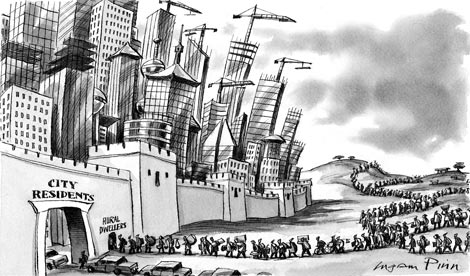For most of its history, the United States has measured its
progress according to the growth of its cities. In the last 200 years,
cities have expanded very fast and many have become centres of
commercial and industrial activity, and of political, artistic and social
life. There has also been an increasing number of foreign
immigrants, people from different countries, moving to America to
settle down and internal migrants, people within the country, moving
from farms and rural areas to cities. In recent years, however,
something unexpected has happened and this pattern has changed.
For the first time in two centuries, the countryside is growing faster
than the cities.
The change from a pattern of migration into the urban areas to one
of migration to rural areas happened quite suddenly. For example,
from March 1970 to March 1974, almost six million people moved
out of the cities, while only a bit more than four million moved in.
The changing migration pattern can best be seen in the largest
cities of America. Five of the eight largest cities - New York,
Chicago, Los Angeles, Philadelphia and Detroit - have actually lost
population since 1970. The change seems to show that Americans
do not enjoy living in urban areas anymore. Small rural towns have
suddenly become more attractive.
Many reasons are offered in explanation of the decrease in
movement to the cities. Some of the most recent explanations are
those that mention the disadvantages of living in the cities because of
food, energy and job shortages. Other urban problems often
mentioned are crime, drugs, pollution and transportation.
Another reason why people choose to live in rural areas is
probably the growth of colleges and universities in areas outside the
cities. Other reasons are the environmental movement, which has
been started by people who are in search of cleaner air and water,
and the improvement in the living standards of rural communities.
Many people today have bought farmland which belonged to
people who migrated to the city, and most have started to provide the
major part of their needs by growing crops and raising farm animals.
The setting up of small and medium-sized manufacturing plants
(factories) in rural areas has also attracted people from cities.
Although such factories pay lower wages than those in large cities,
they provide employment for both men and women and help to
increase rural income. With the increasing possibility of finding
jobs, rural areas have become more attractive places to live in.
Recent improvements in highway systems and transportation
facilities help to keep people in the countryside. Many of the people
living in rural areas still work in the city but can easily drive to and
from work using the interstate highway system.
The return to rural areas, however, does not mean that the United
States is going to become a rural society. About 75% of the U.S.
population still lives in cities and hundreds of thousands will
continue to move to cities each year.
progress according to the growth of its cities. In the last 200 years,
cities have expanded very fast and many have become centres of
commercial and industrial activity, and of political, artistic and social
life. There has also been an increasing number of foreign
immigrants, people from different countries, moving to America to
settle down and internal migrants, people within the country, moving
from farms and rural areas to cities. In recent years, however,
something unexpected has happened and this pattern has changed.
For the first time in two centuries, the countryside is growing faster
than the cities.
The change from a pattern of migration into the urban areas to one
of migration to rural areas happened quite suddenly. For example,
from March 1970 to March 1974, almost six million people moved
out of the cities, while only a bit more than four million moved in.
The changing migration pattern can best be seen in the largest
cities of America. Five of the eight largest cities - New York,
Chicago, Los Angeles, Philadelphia and Detroit - have actually lost
population since 1970. The change seems to show that Americans
do not enjoy living in urban areas anymore. Small rural towns have
suddenly become more attractive.
Many reasons are offered in explanation of the decrease in
movement to the cities. Some of the most recent explanations are
those that mention the disadvantages of living in the cities because of
food, energy and job shortages. Other urban problems often
mentioned are crime, drugs, pollution and transportation.
Another reason why people choose to live in rural areas is
probably the growth of colleges and universities in areas outside the
cities. Other reasons are the environmental movement, which has
been started by people who are in search of cleaner air and water,
and the improvement in the living standards of rural communities.
Many people today have bought farmland which belonged to
people who migrated to the city, and most have started to provide the
major part of their needs by growing crops and raising farm animals.
The setting up of small and medium-sized manufacturing plants
(factories) in rural areas has also attracted people from cities.
Although such factories pay lower wages than those in large cities,
they provide employment for both men and women and help to
increase rural income. With the increasing possibility of finding
jobs, rural areas have become more attractive places to live in.
Recent improvements in highway systems and transportation
facilities help to keep people in the countryside. Many of the people
living in rural areas still work in the city but can easily drive to and
from work using the interstate highway system.
The return to rural areas, however, does not mean that the United
States is going to become a rural society. About 75% of the U.S.
population still lives in cities and hundreds of thousands will
continue to move to cities each year.
